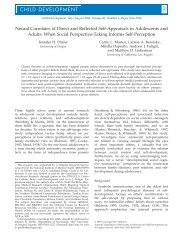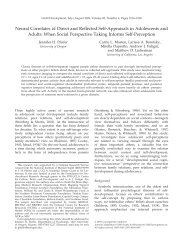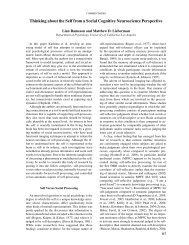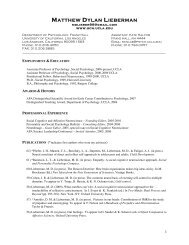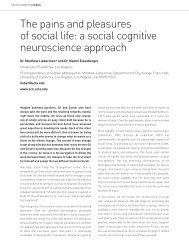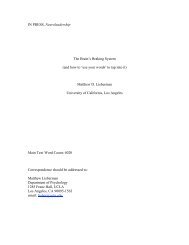In Progress – DO NOT CITE Attributional inference across cultures ...
In Progress – DO NOT CITE Attributional inference across cultures ...
In Progress – DO NOT CITE Attributional inference across cultures ...
Create successful ePaper yourself
Turn your PDF publications into a flip-book with our unique Google optimized e-Paper software.
Culture, Attribution, & Automaticity<br />
26<br />
these effects, though counter to Trope and Alfieri’s findings, did not vary by culture and<br />
thus cannot account for our earlier findings.<br />
General Discussion<br />
<strong>In</strong> three studies of the automatic and controlled aspects of attributional <strong>inference</strong><br />
in US and EA samples, two results consistently emerged. First, automatic attributional<br />
habits were substantively the same <strong>across</strong> <strong>cultures</strong>. <strong>In</strong> each study, both US and EA<br />
participants automatically generated strong attributions to the focus of their inferential<br />
goal. <strong>In</strong> studies 1 and 3, participants had dispositional goals and made strong automatic<br />
attributions to the target’s disposition, whereas in study 2 participants had a situational<br />
goal and made strong automatic attributions to the situation. <strong>In</strong> two of the three studies,<br />
the magnitude of this automatic attribution was nearly identical <strong>across</strong> <strong>cultures</strong>, whereas<br />
in study 3, EA participants actually produced a larger attribution to the target’s<br />
disposition. Across studies, the meta-analytic combination (Rosenthal, 1991) of<br />
attribution extremity in the direction of the inferential goal was highly significant for both<br />
US, Z=7.55, p=2.12 x 10 -14 , and EA samples, Z=7.55, p=2.15 x 10 -14 .<br />
The second result that emerged <strong>across</strong> studies 1-3 suggests that US and EA<br />
participants applied different attributional theories when they were not under cognitive<br />
load and therefore able to employ their conscious theories. US participants appeared to<br />
have applied the normative principles of augmenting and discounting. <strong>In</strong> studies 1 and 2,<br />
there was additional information available that provided alternative accounts for the<br />
anxious behavior other than the focal cause (i.e., the focus of their inferential goal). US<br />
participants responded by discounting the focal cause, making weaker attributions when<br />
they were not under cognitive load relative to when they were under load. <strong>In</strong> study 3, the



